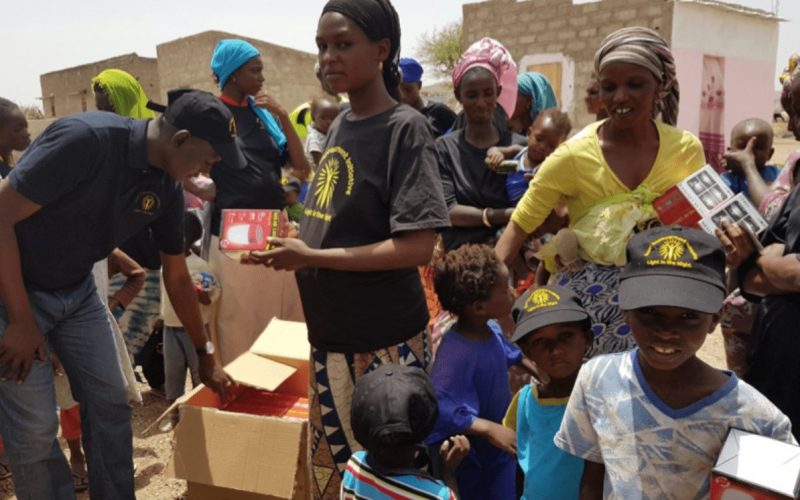
Our friends at Solar Empowerment Initiative do their part bring clean, safe light to those off the grid. They travel the world to bring solar lights to those that need it, but can’t afford it, and help the many homeless individual in our neighborhoods right here in the DMV. Read about their most recent trip to Senegal and how they’re doing their part to make the world a little brighter and better for everyone.
–
I spent the first three weeks of April in Senegal. We accomplished a lot, and I thank each and everyone of you for helping make this possible. I say “we” because in Senegal, and now in Gambia, we have partners who help make our efforts successful. I want to talk to you (1) about the villages we visited and the solar lanterns we distributed, and (2) about our partners and the relationships we are developing.
This trip was made particularly special because my daughter-in-law Laura and grandson Conrad were able to join me for the first week and go the first village with me, as well as to the Peace Corps Training Center and the Tostan compound, both in Thiès.
Overall, I visited four villages and one school. As always, Amad Ba served as my right-hand man. He drove; he translated; he handed out lanterns; and he kept the records of who got what. He was also of great assistance when we met with our non-English speaking partners. More about that later.
The first village was Colobane Thiombane. It is a relatively large village, but still far off the electrical grid. It is also the site of a public school with 125 students and six classrooms. While we were distributing lanterns, the director of the school approached me. Like the rest of the village, the school did not have any electricity. He wanted to know what we could do for his students. Fortunately, of the three types of solar lights that we had shipped to Dakar, there were ten that were somewhat larger, with a larger solar panel, two very bright lights, and two USB ports for charging cell phones. Efforts to advance women in society is something we encountered regularly in our travels.
Conrad and Laura took an active role in distributing lanterns. I think it is an experience that Conrad particularly will never forget.
The second village was Keur Moussa Ka. It is a Pulaar village, and possibly the poorest village I have yet visited in Senegal. There were no men in the village when we got there. The Pulaar are traditionally herdsmen, and all the men and boys were out with the herds. Later, an old man arrived with a donkey cart loaded with water. Not only did the village have no electricity, it had no water.
The third village was Touba Dieng. This village was selected by our partner, Tostan, and Oumou Diop from Tostan (on the left) went with us and took charge of the distribution. I was impressed by both her firm hand and her quick smile.
The farthest village we visited was Mdiasse. It is east of Kaolack near Cissé Mass. Some of you may recall that Cissé Mass was the first village that gave solar lights to back in 2016. Our plan now is to return there every year and provide lanterns to one village in the area. Moustapha Cissé is our point of contact there and he selects a new village each year.
There is more. Thanks to our partners, our reach is farther than just the villages that I can personally visit.
The largest Peace Corps effort in Africa is in Senegal There is a Peace Corps Training Center in Thiès, just a couple hours from Dakar, through which all Peace Corps volunteers in Senegal pass. We left them with two cases of lanterns (96 lanterns). These will be distributed to the trainees in the next class, with instructions on how to contact us. The coordinator cautioned me that this could result in more demand than we can handle. That could certainly be the case, but I am hopeful that our generous supporters will rise to the opportunity. They agreed to assist us in getting lanterns to their distant volunteers. This greatly simplifies what would otherwise be a logistical nightmare.
Tostan is an international charity with its roots in Senegal. The name means “breakthrough” in Wolof. As already discussed, we went to the village of Touba Dieng with Tostan’s Oumou Diop. In addition, we left two cases of lanterns with Tostan that it will turn over to a women’s organization that it works with. Proceeds will be used to fund a community project. A small part will also be returned to us to help cover our in-country expenses. All money remains in Senegal.
We now have a similar arrangement with two other partners: APROFES (Association for the Promotion of the Senegalese Woman) in Kaolack, and with Londoo Looloo in the distant region of Sedhiou. Fortesa International Senegal graciously provides logistical support, to include meals, lodging, a vehicle and a driver whenever we are in Senegal. This means that the money you donate goes almost entirely for the purchase of solar lights. We have almost no overhead.
There has been a lot happening here at home as well, but I will save that for the next newsletter.
Please keep up your support. Your donations are truly changing lives.
Sincerely,
Michael H. Varhola
President, Solar Empowerment Initiative
Project Manager, Solar Village Project
If you are getting solar from: